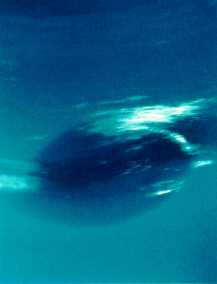This is an image of Neptune's Great Dark Spot of 1989.
Click on image for full size
NASA
Neptune's Great Dark Spot of 1989
Unlike Jupiter's Great Red Spot, the Great Dark Spot of Neptune is thought to be a hole in the methane cloud deck of Neptune. The white clouds shown in the picture are above the "hole". In many images of Neptune, the Great Dark Spot can be seen to change size and shape.
The Great Red Spot of Jupiter is thought to be a hurricane which has been raging on Jupiter for at least 400 years. The Great Dark Spot, seen here by Voyager in 1989, disappeared in 1994, and was replaced very soon by a similar "Spot" in a similar place, but in the northern hemisphere instead of in the southern hemisphere.
The Great Dark Spot of 1989 either dissipated or is currently masked by other aspects of Neptune's atmosphere. Whatever the reason, its disappearance demonstrates that Neptune has a dynamic, rapidly changing atmosphere.
You might also be interested in:

This image shows the new Great Dark Spot of Neptune, which was discovered using the Hubble Space Telescope. The image shown here, shows a "hole" in the clouds of Neptune in pink, in the northern hemisphere,
...more
Like Jupiter and all the giant planets, Neptune's appearance shows a striped pattern of clouds. Other cloud shapes seen over time include a small dark spot, the "scooter" and the Great Dark Spot. The Great
...more
Neptune's atmosphere shows a striped pattern of clouds. This cloud pattern is very similar to that of Jupiter and Saturn. Neptune even has a Great Dark Spot similar to Jupiter's Great Red Spot. The structure
...more
Atmospheres of the giant planets have definitely evolved from their formation out of the primitive solar nebula. How much they have evolved remains to be seen, however. Because of their enormous gravity,
...more
This image shows some cirrus clouds, extending for many kilometers across the disc of Neptune. These clouds are somewhat high up, for they can be seen to cast shadows on the lower clouddeck, which is 35
...more
This image of Neptune uses false colors to bring out the hazes of smog, which can be seen in red along the limb of Neptune, at the edge of the picture. These hazes of smog are found at very high altitudes,
...more
The solar system contracted, or shrank together, out of a spinning cloud of hydrogen and helium gas. This spinning cloud had a certain amount of momentum, which caused it to flatten, somewhat the way a
...more
If you had a quiz question in school that asked what year Neptune was discovered, you'd probably choose 1846. But Neptune wasn't discovered the way all the other planets in our solar system were. Astronomers
...more













